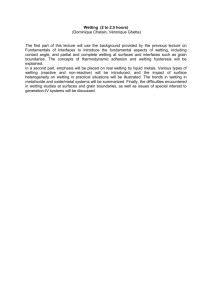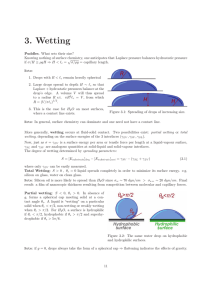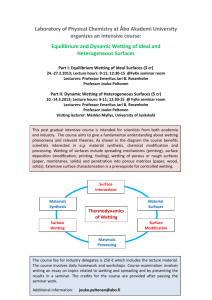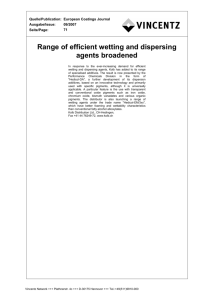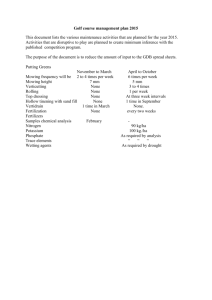RIAG Cr Wetting Agent - AHC Oberflächentechnik
advertisement
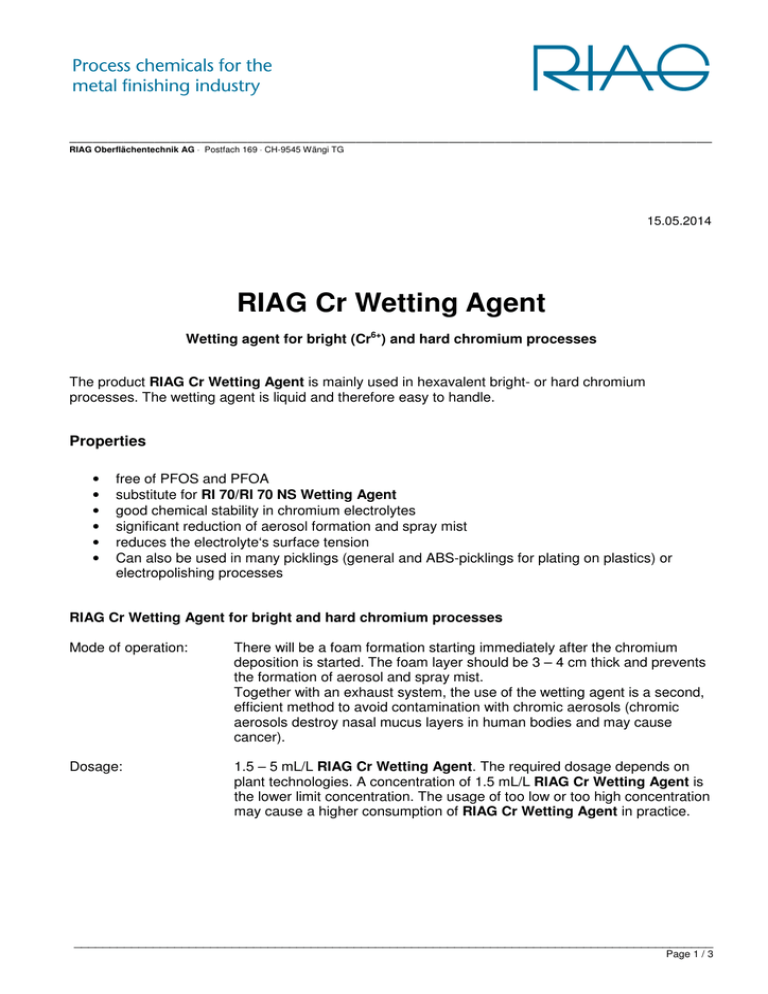
___________________________________________________________________________________ RIAG Oberflächentechnik AG ⋅ Postfach 169 ⋅ CH-9545 Wängi TG 15.05.2014 RIAG Cr Wetting Agent Wetting agent for bright (Cr6+) and hard chromium processes The product RIAG Cr Wetting Agent is mainly used in hexavalent bright- or hard chromium processes. The wetting agent is liquid and therefore easy to handle. Properties • • • • • • free of PFOS and PFOA substitute for RI 70/RI 70 NS Wetting Agent good chemical stability in chromium electrolytes significant reduction of aerosol formation and spray mist reduces the electrolyte‘s surface tension Can also be used in many picklings (general and ABS-picklings for plating on plastics) or electropolishing processes RIAG Cr Wetting Agent for bright and hard chromium processes Mode of operation: There will be a foam formation starting immediately after the chromium deposition is started. The foam layer should be 3 – 4 cm thick and prevents the formation of aerosol and spray mist. Together with an exhaust system, the use of the wetting agent is a second, efficient method to avoid contamination with chromic aerosols (chromic aerosols destroy nasal mucus layers in human bodies and may cause cancer). Dosage: 1.5 – 5 mL/L RIAG Cr Wetting Agent. The required dosage depends on plant technologies. A concentration of 1.5 mL/L RIAG Cr Wetting Agent is the lower limit concentration. The usage of too low or too high concentration may cause a higher consumption of RIAG Cr Wetting Agent in practice. _________________________________________________________________________________________ Page 1 / 3 _________________________________________________________________________________________ RIAG Oberflächentechnik AG Additive consumption: The additive is consumed during electrolytic reactions as well as drag-out losses and other side-effects; therefore the use per 10 kAh can vary. Other side-effects are a bundle of effects that may increase the additive consumption. Examples are impurities, especially additional metals like iron as well as suspended particles, and subsidiary oxidative stress from the chromium species itself as a long-term effect (exposure time). RIAG Cr Wetting Agent Maintenance: 0.2 – 1.0 L/10 kAh The consumed RIAG Cr Wetting Agent should be added regularly. If the consumption is high enough, it is recommended to add the RIAG Cr Wetting Agent once a shift. Dilute the RIAG Cr Wetting Agent 1:5 up to 1:10 with deionized water. Add only the diluted solution to the electrolyte. If the rinsing water is recycled, the deionized water can be replaced with the rinsing water in the dilution step (Be sure that the rinsing water source is deionized water only). It is recommended to spread all additions over a wide area of the electrolyte. Conversion process In principle, the (floating) conversion from RI 70 / RI 70 NS Wetting Agent to RIAG Cr Wetting Agent is possible. Aged electrolytes may contain nuisance-causing substances, e.g. additional metals. To avoid any inconvenience, a floating conversion check is recommended. This floating conversion check is done at the RIAG laboratory. During the conversion process, the foam formation may appear in a different manner. It is possible that the foam layer is thinner than usual. As long as this foam layer is closed, the wetting agent combination significantly reduces aerosol formation. This condition is a temporary effect. If the old wetting agent is used up, the conversion step is finished and the foam formation shows a stable, normal state. During the conversion process, it is recommended to observe the foam surface state. If the closed foam layer begins to crack, add RIAG Cr Wetting Agent in steps of 0.5 mL/L. Use a dilution of 1:5 up to 1:10 with water as mentioned above (see chapter Maintenance). Only add a part of the diluted solution. It is only necessary to close the foam layer again. The addition of more RIAG Cr Wetting Agent as needed is counterproductive in respect to increasing consumption rates. Even though the RIAG Cr Wetting Agent can be used universally and is compatible with many other products, the conversion from this products should be checked separately in laboratory scale before its use in production. In rare cases, it is possible that a floating conversion is not possible. It may be necessary to degrade the old wetting agent before the RIAG Cr Wetting Agent can be added. Additionally, after degradation of the old wetting agent, it may be necessary to clean the tank and anodes. Waste water treatment / Environmental protection Although the product RIAG Cr Wetting Agent will decrease the drag out, concentrates as well as their rinsing waters contain chromium (VI) and are extremely dangerous for waste water treatment plants. The waste water needs to be treated according to legal regulations before getting into the canalisation. _________________________________________________________________________________________ RIAG Cr Wetting Agent Page 2 / 3 _________________________________________________________________________________________ RIAG Oberflächentechnik AG Safety arrangements We recommend wearing safety glasses, gloves and protective clothing while working with chromic acid. For further information please consult the safety data sheets. Chemicals must not be stored under 10 °C. Guarantee The technical information and recommendations in the operating instruction are based on practical testing and are reliable, but are given without warranty or guarantee. The use of our products might vary according to local conditions and materials processed. We reserve the right to change or amend the operating instruction based on technological advances. The sale of our products is subject to the sales conditions of our company. RIAG Oberflächentechnik AG Murgstrasse 19a CH- 9545 Wängi Tel. + 41 (0) 52 / 369 70 70 Fax + 41 (0) 52 / 369 70 79 www.ahc-surface.com info.waengi@ahc-surface.com _________________________________________________________________________________________ RIAG Cr Wetting Agent Page 3 / 3
